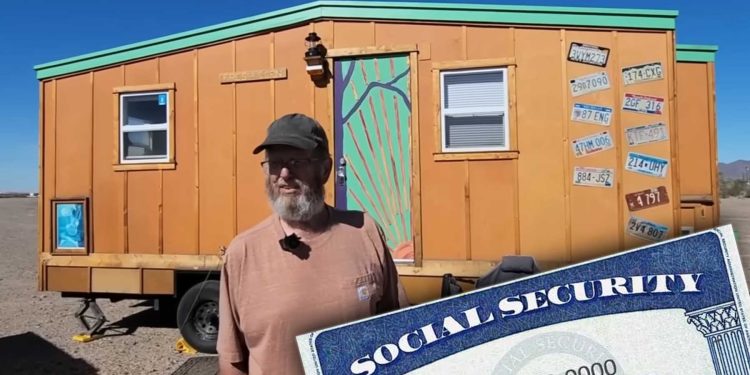Today we have the opportunity to meet Alan, a retiree who lives in a small house that he built himself and that only costs him $25 of cost of living expenses per month. The way you hear it: Alan pays virtually no rent and lives on his social security retirement. Since his wife passed away, Alan has been on the road living a relaxed and quiet life, embarking on one of the most important adventures of his life: adopting the concept of “downsizing” to have a cheaper cost of living in a Tiny House and with an austere and sober lifestyle, without sacrificing well-being.
On a recent interview for a YouTube Channel, Alan tells that he lives exclusively on his Social Security benefits and occasionally works as a food delivery at DoorDash. He might well not work, he says, but he likes to have some extra income to travel and cover unexpected expenses. As he explains, he works less than 10 days a month, which gives him enough flexibility to enjoy the rest of the free time.
Living Tiny Only on Social Security Benefits
As for his Tiny House, Alan tells us that he went to Portland, Oregon, to a place called Iron Eagle, where he found a small trailer specially designed for Tiny Houses. Then he decided to build his home, opting for a structure that is not a traditional recreational vehicle, but a real home with everything you need. He proudly tells in his videos how he loves his house, especially because he built it with his own hands.
Alan’s tiny house is equipped with solar panels, large-capacity batteries and all the appliances one could need, including a microwave and a toaster. He shows us the small spaces he has ingeniously created to store his belongings and tells us about the constant repairs and adjustments he must make to keep everything in good condition.
The retiree who pays $15 a month in rent: Where’s the catch?
There is no hidden trick behind the “downsizing”. Retirement and Social Security experts have recommended for years to reduce the cost of living after you stop working to try to live only on the income from retirement savings. This is extremely obvious: that big house that you and your partner built with effort for decades, which was once full of children, now remains giant and empty for a retired couple.
Alan’s case is special because, in addition, he is a widower, so a house for him alone was going to be even more unnecessarily large. Alan highlights the flexibility and autonomy he has gained from this lifestyle, as he does not pay rent. In fact, he only costs $180 a year, only $15 a month, for a permit that allows you to camp with your Tiny House in designated areas, and thanks to this, you can move freely while working and living in your beautiful and tiny mansion, where he enjoys his retirement.
Because, hey, a mansion doesn’t have to be a house of hundreds of millions of dollars: as long as it is full of good energies, love, and the basics to live with a good quality of life, in your head that can be your mansion. It doesn’t matter how many square feet you have of floor space.

“Downsizing” After Retirement: One Trick o Consider to Save Thousands
The construction of his house and the purchase of the van were made possible thanks to a small insurance policy that he shared with his wife. The arrangements he has been making over time have cost him a few hundred dollars, which are still much lower than having a mortgaged house or a rental.
Although he misses his three children and grandchildren, Alan is committed to his nomadic life. They didn’t lose contact with them because they talk to each other every day. She plans to continue living in her tiny house and move to warmer climates during the winter. In the future, he dreams of increasing his self-sufficiency, perhaps by acquiring an electric vehicle such as the F-150 Lightning.
Alan tells us that his current pickup, an F-150, gives him about 9 to 10 miles per gallon when towing the house, and 19 to 20 miles per gallon when it’s unloaded. This performance surprises and satisfies him, considering the weight of the trailer.

